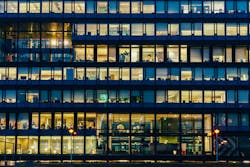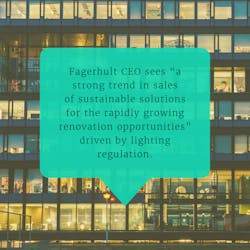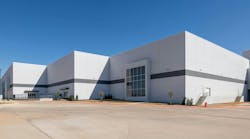Fagerhult Group reported another quarterly rise in sales and profits, as its emphasis on the renovation and retrofit market continued to pay off. The outlook continues to look promising, abetted by EU laws regarding energy efficiency and fluorescent bans, the company said.
CEO Bodil Sonesson also credited a growing trend in which the Swedish company has been able to combine products from across its 12 companies into single projects, which she described as a positive impact from a reorganization that took hold some three years ago.
Sales at the Habo-based group jumped nearly 18.7% to 2.22 billion Swedish krona (SEK; $215.2 million) in the first quarter ending March 31, from SEK 1.87 billion ($181 million) in the first quarter of 2022. The increase was 14.3% when adjusted for currency effects. Net profit for the quarter leapt 32% to SEK 157.9 million ($15.2 million) from SEK 119.5 million ($11.6 million) a year ago, as operating margins rose to 11%, which Sonesson said were the highest for the first quarter in several years. They were 9.3% a year ago.
As Fagerhult did after its Q3 2022, it pointed to the importance of the renovation and retrofit markets, especially as European Union green regulations strengthen and encourage the uptake of energy-efficient LED lighting. Fagerhult claims that LED illumination can save up to 90% in energy consumption when outfitted with smart controls.
Fluorescent fade
In addition to green legislation, the EU’s staggered fluorescent ban, which takes full effect at the end of the summer, looks set to buoy LED sales for several years, Sonesson noted. The ban is not aimed at reducing energy consumption. Rather, the EU is banning fluorescents because they contain mercury, a hazardous substance.
“A strong trend in sales of sustainable solutions for the rapidly growing renovation opportunities, as well as the EU regulation that bans fluorescent lighting starting in September this year, means that in the coming years we will have high demand in the market for upgrading and replacing luminaires,” Sonesson said on a call with analysts on April 26.
Fluorescent lighting products already on the market are legal, but the ban prohibits new ones from being manufactured. Thus, Fagerhult anticipates a prolonged boost to LED sales, as users replace aging fluorescents over time.
“I don’t think [fluorescent replacement] will be one big spike; I think you will see it consistently being part of our growth drivers for quite a long time to come,” Sonesson said. Chief financial officer Michael Wood added that across the general lighting supply chain, “we can imagine there will be distribution warehouses crammed to the ceilings with these [fluorescent lighting products].” He noted that about 65% to 70% of Europe’s buildings are still lit by fluorescent light sources, so steady LED-replacement business prospects are good.
Sonesson further observed the need to educate installers on replacing fluorescent lighting with LED, since one-to-one swaps of tubes are not always feasible, and more full luminaire replacements are in order.
“If you go in and only change the fluorescent lighting without looking at the complete luminaire solution, you will, for example, break the CE ceiling of it,” she said, referring to the European equivalent of UL safety certification in the U.S.
Like Fagerhult, Norwegian LED lighting vendor Glamox has also cautioned against tube-for-tube replacements. Both Fagerhult and Glamox sell integrated LED luminaires, not LED tubes.
Calling all brands
In another positive trend, Sonesson said Fagerhult is increasingly pulling together brands from its stable of 12 companies to supply projects, such as at the Platinan office building in Gothenburg, Sweden, and the Fjelltun primary school in Stavanger, Norway — each of which used products from several Fagerhult businesses.
“They show that more and more we cooperate between the different brands in the market to be able to offer lighting solutions for every customer need,” Sonesson said.
Fagerhult divides its business into four segments: the design-oriented Collection division, with iGuzzini (including Montreal-based Sistemalux), ateljé Lyktan, LED Linear, and WE-EF brands; Premium, which focuses on European customers and bespoke solutions via Fagerhult and LTS brands; Professional, which focuses on indoor lighting in local markets and includes Australia's Eagle, the U.K.’s Whitecroft, and Turkey's Arlight; and Infrastructure, aimed at robust environments and including the brands Designplan, i-Valo, and Veko. It also offers the Organic Response smart lighting connectivity for indoor use and City Grid for outdoor, both of which it can add into the luminaire mix of the 12 different lighting companies that it operates.
The company made little to no mention of IoT progress or of pricing, both of which have featured in recent quarterly reports.
It wasn’t a completely stellar quarter, as the company noted that inventory levels had unexpectedly risen. But Sonesson was adamant that Fagerhult is focused on bringing the levels down.
The overall corporate outlook is good, despite some continuing market uncertainty, she said.
She also singled out a couple of new products Fagerhult introduced in the first quarter that feature re-use and sustainability attributes. LEDs Magazine will report on these separately.
MARK HALPER is a contributing editor for LEDs Magazine, and an energy, technology, and business journalist ([email protected]).
Follow our LinkedIn page for our latest news updates, contributed articles, and commentary, and our Facebook page for events announcements and more. You can also find us on Twitter.






